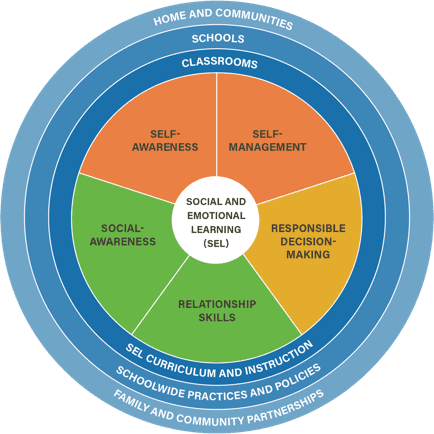In today's world, social and emotional learning, or SEL, is more important than ever before. It begs the question: how do we create opportunities for social and emotional learning with everything else going on?
Digital portfolios offer one easy-to-implement solution to SEL. This blog explores what SEL is, how digital portfolios can be used to support the classroom implementation of SEL, and practical activities educators can leverage to have students focus on SEL in any environment.
What is Social and Emotional Learning?
According to the Collaborative for Academic, Social, and Emotional Learning (CASEL), social and emotional learning is the way in which people manage emotions, have positive relationships with others, make responsible decisions, and set and achieve goals. CASEL has divided SEL into five different competencies:
CASEL Wheel & Competencies
- Self-awareness: The ability to recognize one’s own emotions
- Self-management: The ability to regulate one’s own emotions
- Social awareness: The ability to take into consideration others’ perspectives
- Relationship skills: The ability to create healthy relationships with others
- Responsible decision making: The ability to make positive, respectful choices
Why digital portfolios?
Digital portfolios help learners develop an increased understanding of why and how they learn as well as critical thinking and communication skills.
While digital portfolios serve to capture and document student learning and have students reflect on this learning, their true power is in their ability to make learning transparent, provide differentiation, and give students ownership over their learning.
So how do digital portfolios allow you to teach social and emotional learning while ensuring students are still learning remotely? Portfolios act as a bridge between social and emotional learning and curriculum.
1. Student Portfolios Enable Educators to Provide Effective and Timely Feedback and Evaluations
By having students upload project and activity drafts throughout the creation process, rather than waiting until they are finished to hand in an assignment, you can see student progress, provide continuous feedback that is immediately visible to students, and guide them in the right direction. You can achieve this on SpacesEDU by submitting feedback in the Comments section of any post and activity. By receiving this feedback early on throughout the process, students are better able to embrace their ability to learn and improve as they work.
2. Digital Portfolios Encourage Students to Reflect on What and How They’re Learning Throughout the Process
Simply writing a character analysis or doing an experiment does not force students to think about the “why.” By having students document their learning and taking the time to reflect throughout the process, it allows students to understand how their learning is impacting them personally and changing them.
3. Portfolios Create a Canvas for Students (and Educators) to See Their Growth and Change
With Activities, students can easily upload their first draft of an assignment, receive feedback from you, reflect on their feelings towards it, make changes, and upload their final assignment. They can then receive their grade and final feedback, and reflect on their progress, growth, and change both about their knowledge and skills, as well as their ability to receive feedback and learn. Educators can even connect their feedback to learning objectives with Curriculum Tags.
How to Have Students Use a Digital Portfolio for SEL
Tying portfolios to social and emotional learning is a natural fit, and any activity can be turned into opportunities to capture, develop, and showcase SEL skill development, all while students are learning.
Here are four activity ideas to have students focus on SEL development using SpacesEDU's Individual Space feature for portfolios.
1. Goal Setting
Goal Setting is an easy way for teachers to incorporate SEL into what they're already having students work on, as it allows students to self-assess their ability to take feedback, recognize when they are getting frustrated as they work towards their goals, understand how their confidence is impacted by different feedback, how they’re managing their stress, and staying motivated.
Not only is goal setting an easy way to work towards SEL development, but by having students set goals for themselves while learning remotely, they are more likely to remain focused and on track.
Idea: Standards-Achievement Goal
If a student is working towards improving or achieving specific standards during the term, they can set specific goals to help them succeed. This student (Sarah) is working on improving her Speaking and Listening standards mastery. To do this, she is working towards significant improvements in her public speaking. As you can see, she has set three goals for herself: Achieve 80% (this is teacher-assessed), reduce her use of filler words (again teacher-assessed), and feel more confident in her ability to speak in front of the class (this is self-assessed).
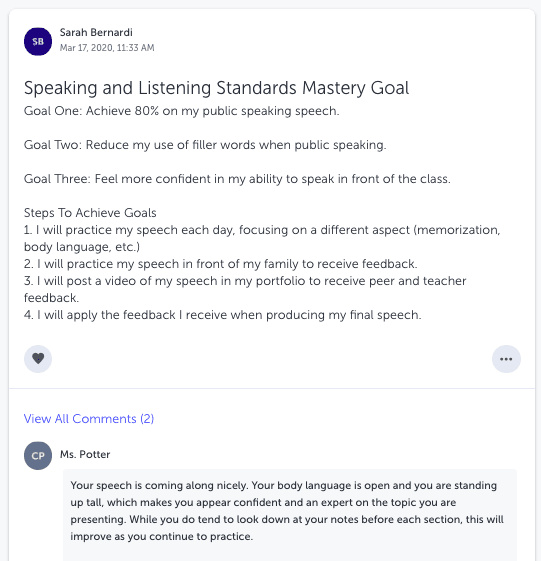
After having set these goals, throughout the assignment that is being worked on in class, the student can upload a video practicing the speech and receive peer, teacher, and family feedback on the goal.
The student can then reflect on that feedback thinking about how it motivated them or made them feel.
Idea: Problem-Solving Goal
Any problem-solving challenge that can lead to frustration, anxiety, and stress, can be an excellent area to develop SEL skills.
In math class, why not have students set a goal around a particular concept or skill, such as learning the Pythagorean Theorem and applying it to solve problems?
- After having set this goal and been assigned a set of problems to complete, students can upload a video of themselves solving the problems and walking through the steps they took.
- Once teachers provide feedback from within their account, students can reflect on that feedback, thinking about how it motivated them to improve or how it made them feel.
- Students can then reflect on their progress towards achieving their goal, taking into account any barriers to learning that may have impacted them while attempting the problem set.
From a social and emotional learning standpoint, this goal-setting task and reflection piece aligns closely with both self-awareness and self-management.
2. Journal Entries
Documenting learning and reflecting using journal entries is another way to have students develop their social and emotional learning through activities educators are already having students complete. They can document their reflections using any multimedia options available on SpacesEDU. For example, students can attach a podcast they recorded instead of solely creating text-based posts.
Idea: Character Analysis
In English Language Arts, why not have students do a character analysis throughout an assigned reading? Each week or chapter, students could write a new reflection on how the character is developing any of the five social and emotional learning competencies. Take for example Romeo and Juliet and the SEL competency, “responsible decision making.”
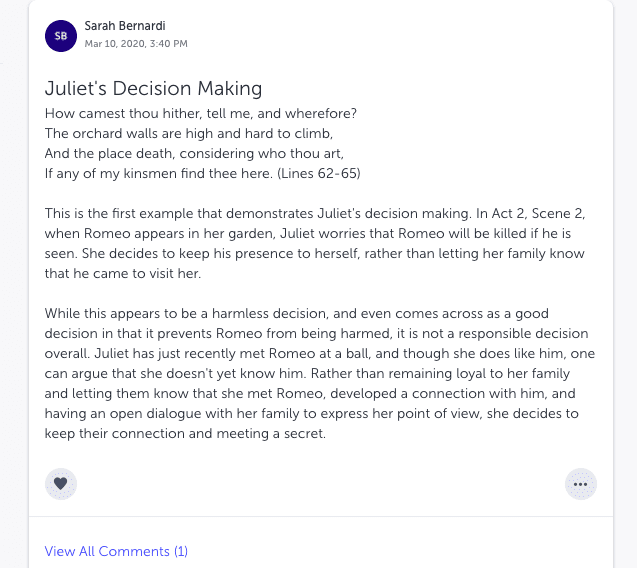
Having students examine the different decisions that Juliet makes throughout the play, reflecting on how her decision-making was irresponsible and the impact that it has, and exploring how they would have approached the situation differently, allows students to learn not only the content of Romeo and Juliet but also critically think about responsible decision making.
Social self-analysis is the process in which one’s self-concept is formed or changed through comparing and contrasting one’s own behavior, emotion, or attitude to another person’s. It makes sense that observing behaviors in others can make us more aware of the behaviors in ourselves, and this can easily be turned into any subject-specific activity.
Idea: Passion Blogging
Passion blogging is a great way to keep students working those writing muscles, but prompting students to think critically about those passions can also help develop SEL as well. (Read more on passion blogging with portfolios.)
Passion is a powerful emotion, so helping your students understand it, manage it, and use it for good is a lifelong skill.
Because a topic of passion is familiar and interesting to students, it can help students feel safe writing about their emotions given it's a topic area they're comfortable with.
Consider some probing questions to respond to students' blogs, such as:
- How would you explain your topic to someone new?
- Why do people disagree with your stance or perspective on this topic?
- Try writing about this from the perspective of someone else, how do perspective and experience change your work?
3. Community Connections
It's no secret that global citizenship is a competency that many school districts are working to help students develop. In learning about others, it can help us learn more about ourselves in the process.
Idea: Community Interviews
For educators in career education, community interviews can be an extraordinary exploration task for students to learn more about careers that interest them. But in any subject area, from science and technology to music or arts, speaking to people who are engaged in the field of study can serve a dual purpose: Content discovery and SEL!
Students can prepare for the interview by writing their interview questions and researching necessary skills, such as active listening, learning how to empathize with those who share different opinions, etc.
They could then either record an audio or video clip of the virtual interview, upload it to their portfolio, and write a reflection on their learning and the differences in perspective and background that exist between themselves and their interviewee.
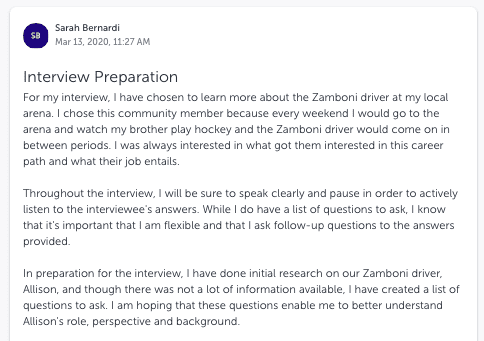
Not only does this type of media-rich activity allow students to develop their social awareness and relationship skills through interacting with different people and critically reflecting on their differences, but it also allows students to connect with those around them during this challenging time.
Bonus Idea: use this lesson plan to have students explore the concept of citizenship by brainstorming and helping solve a real-world issue.
4. Guiding Students Towards Mental Wellness
If the COVID-19 pandemic taught us anything, it's how important mental health and well-being are both for educators and students.
Having students explicitly examine the concept of mental health and self-assess how they are feeling will allow students to have an honest check-in with themselves while developing both their self-awareness and self-management SEL competencies.
Idea: Mental Health-Focused Exploration
As part of physical education and health class, why not have students examine the concept of mental health and some strategies and supports that are available to them? Consider having students conduct research and then write a journal entry or record a video or audio clip with the following information.
- What is mental health?
- What is stress?
- What are 2 stress management strategies that you can try?
- What are 2 community resources or supports that are available to you?
Idea: Daily Reflection Journal
Looking to make the connection between SEL and mental health? Have students write a daily journal reflecting on how they are feeling each day and have them monitor how it changes throughout the week.
Have students record a daily video documenting how they are feeling and sharing what strategies they are using to reduce stress and anxiety.
Provide feedback to help students discuss how they are currently feeling and, if they are stressed or anxious, how they can try to manage these emotions.
Through learning about mental health and stress and reflecting on their state of mental health, students will continue to become more self-aware while exploring ways to manage the emotions they may be feeling.
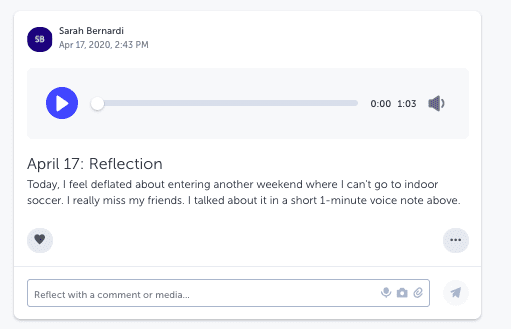
Social-Emotional Learning Has a Positive Impact on Student Achievement and Engagement
Social and emotional skills are two of the most important things educators are responsible for teaching and helping students learn and develop.
These vital skills can have an impact on graduation rates, and they can have an impact later in life on self-esteem, life satisfaction, and self-acceptance. With a little imagination and creativity, educators can incorporate SEL into their students’ learning routines.
By incorporating SEL into one's teaching practice and implementing digital portfolios as a means for reflection and documenting student learning, not only do educators have the ability to provide timely and effective feedback, but they also give students the tools necessary to think critically about their social and emotional skills and development and track their growth over time.

